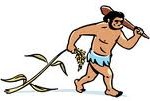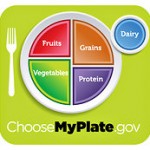The new philosophy of eating is really an old philosophy. In a nutshell, eat clean and wholesome food like early humans did — the tribal sorts who foraged for food, maybe killed some animal for fresh protein if they were lucky, ate lots of raw vegetables, and never pulled into a McDonald’s parking lot in an SUV. Eat like a person for whom the domestication of grains is only just a new concept.
In short, imagine how early humans ate, not including the way they got their food. That is, we are not advocating that you go out with a rifle during the day to terrorize the neighbors’ pets, or dig up edible vegetable plants in the park at night.
Eat the type of foods that they ate. That is, simple, unadulterated foods comprised mostly of fresh vegetables and fruits, nuts and seeds, mushrooms (from the supermarket), meats that are not compromised with antibiotics and hormones, and whole grains (not too much in one sitting).
Here’s Michael Pollan’s take on what to eat: Eat food. Not too much. Mostly plants.
Believe it or not, that is our evolutionary heritage, and that is the type of food that our body is genetically best designed to utilize.
Michael Pollan warns us about “food-like substances” that fill the aisles of the supermarkets of North America. They bear very little resemblance to real, nutrition-bearing food, and have unpredictable results on our bodies. In many cases, processed foods have very negative effects on us.
In a nutshell, here is how to fill up your plate. Divide the plate in half. Then divide one of the halves in half again. In the first quarter pile the grains, not too high.
In the second quarter, put protein foods, like fish and meats, only as thick as the palm of your hand.
Divide the second half slightly unevenly. In the larger part, pile lots of vegetables. In the smaller part, put fruits, or just fill the whole second half with vegetables! Or you may skip the fruits entirely and just eat a wide variety of vegetables.
Some Important Diet Details
Try to eat some raw foods every day, well washed and pesticide-free. Don’t overcook the ones you do cook. For more information, please visit our page on how to steam vegetables.
Try to eat a variety of vegetables. Not only does this avoid boredom, but it brings in many more vitamins and nutrients than you will get from a single vegetable eaten over and over again.
Try to be modest with the grains. They are 1/4 of the contents of our “new” plate, not 3/4. See our whole page on the new Food Pyramid, but here’s the plate to give you a quick visual on how to load up your plate.
Buying Organic
Try to eat fruits and vegetables not sprayed with pesticides. Nobody sprayed the fruits and vegetables for the rag-tag bunch of early humans that are your ancestors, so don’t settle for food loaded with deadly pesticide residues. Buy pesticide-free fruits and vegetables wherever possible.
“Organic” may not be as important as just getting rid of the pesticides. There are lots of small farmers who don’t spray their fruits and produce, but they don’t have the money to get certified “organic.” Find them at farmers markets and U-Pick orchards. Sometimes using Google to find “you pick” with the name of your area in the search will result in lists of places you can go to pick your own cleaner food. Often it’s less expensive, but not always.
My local supermarket labels things “Pesticide Free” and “Not Sprayed,” which helps in selecting products that are cleaner.
We live in a place where organic food is plentiful and not so horribly expensive. We’re lucky, we know. If you can at all, try to buy organic fruits and vegetables. They’re much cleaner and won’t leave you with exposure to 14 different pesticide residues at each sitting.
A Great Alternative
Have a look at the Environmental Working Group Website to see their list of Clean 15 Fruits and Vegetables and Dirty Dozen vegetables and fruits. These are the EWG’s Shopper’s Guide to Pesticides in Produce™, two great lists that should be in your purse or pocket when you buy vegetables.
Clean 15 vegetables/fruits are not typically sprayed to death with dangerous pesticides, so the point is that you may not have to buy organic when choosing from the Clean 15 list. They include such items as onions, avocados, cabbage, pineapples, asparagus, mangoes, papaya, etc. In some cases, the fruits or vegetables are damaged by pesticides, so it’s just not economical for growers to spray them. In other cases, there are not insects or molds present enough to warrant spraying, so they’re pretty clean by nature.
Please note that the list is updated every year so stay current with what’s NOT being doused with deadly pesticides. Please don’t put the awful stuff on your kids’ plates!
The Dirty Dozen (click on the link above to see the list) ARE SPRAYED TO DEATH and you’re really exposing your kids and yourselves to dangerous amounts of pesticide residues if you eat them. Some examples from this year’s list are: strawberries, apples, peaches, celery, grapes, spinach, tomatoes, sweet bell peppers, cucumbers, etc. Buy these organic! I do note that many readers are from other countries, but this is the case in the United States. So much of our food now is imported that we cannot know, much less control, what is sprayed on the food before it lands on our plate.
I do know from discussions with scientists that it is NOT POSSIBLE TO REMOVE ALL THE PESTICIDES from food once it’s sprayed or applied in whatever manner.
Moreover, companies are now manufacturing Roundup-Ready seed; that is, seed that has been genetically modified to withstand terrible doses of Roundup, the agricultural herbicide manufactured by Monsanto. All the other plants, weeds, insects, honeybees, etc., exposed to this herbicide die off, but there stands the Roundup ready plant. Do you think that this herbicide does not end up on your plate in the long run? Think again.
End of pesticide diatribe…. you just don’t need them.
Go reasonable on the carbohydrates. Make that giant heap of pasta on your plate just a little smaller. All those extra carbs only serve to make you fat. Cook whole grain pasta and you will feel plenty filled by a smaller amount. Your body will digest it slowly and you won’t be rushing back into the kitchen for more within the hour. It’s fiber content will get your digestive system in better shape in no time, and you will be less likely to suffer from Type 2 diabetes.
Eat meats that are not from commercial stockyards where the animals are artifically fattened by grains they can’t digest, standing in manure, injected with antibiotics that come through in the food to you, pumped up with hormones, etc.
Our ancestors did not bake box cake mixes in their hand-made clay ovens. Neither should you. Processed food is virtually nutrition-free. Instead of sending armies to defeat our enemies, let’s package up all the processed foods in America and ship them off to enemy territory as a “good will” gesture. We now do that after we have defeated them. Why kill all those people and waste the bullets? The processed food will do the trick.
Early humans ate nuts and seeds to get some of the fats in their diets, though they didn’t have a food pyramid plate to put them on. They had to put work into cracking nuts, pine cones, etc., with rocks to get at the good nutrition that nuts offer. it turns out that fats from nuts are some of the best fats that we can consume; many actually reduce damaging cholesterol in our bloodstream. We do discuss allergies and intolerances to nuts, so read that page before you go out foraging for nuts, even at the supermarket.
As a child, I went out with my parents to collect walnuts from a nearby tree at a certain time of year. First we had to remove the tough, thick covering that stained our hands with a black dye that lasted for days. Then we had to use a hammer to get at the meat of the nut. Because it was so much work, both early humans and my family, too, didn’t eat very many. Let that be our lesson on quantity for nuts. Just a few go a long way but provide excellent protein and high quality fats.
Seeds generally require the same concerted effort to enjoy the meat inside. They are also full of good kinds of fat for the developing plant embryo and for you, too, so go easy, but eat them! For more information, visit our pages on Nuts and Seeds.
Here’s an approach to eating that should lengthen your life, improve the quality of your health, and help you raise healthy kids! It goes without saying that it will also make you appreciate how easy we have it today in our quest for food.





Why do I bother dialing up people when I can just read this!